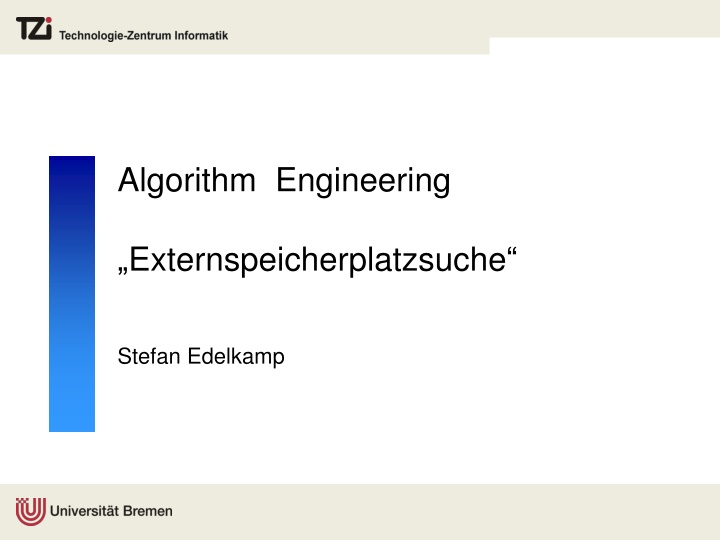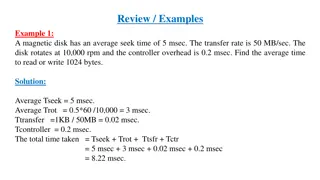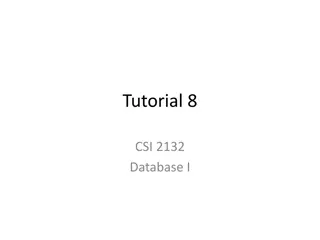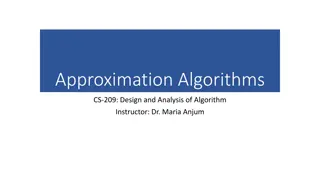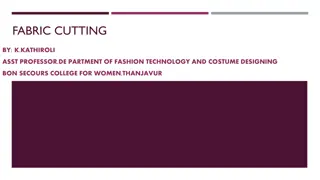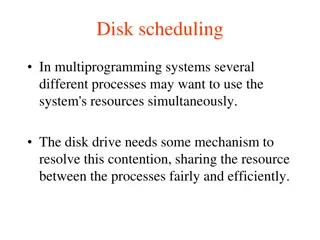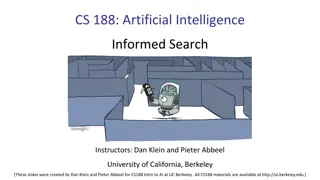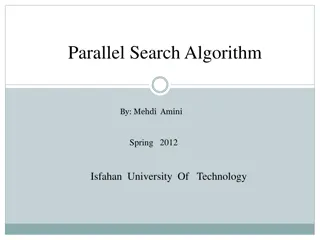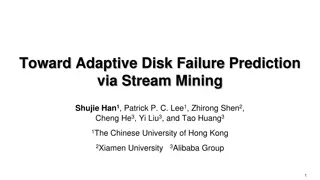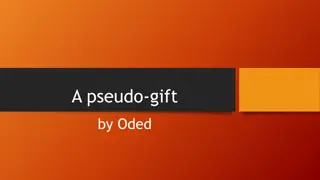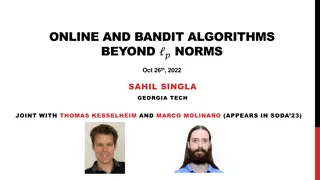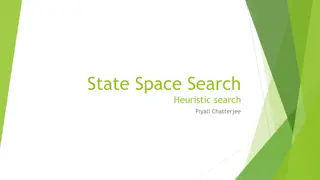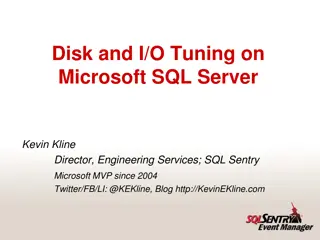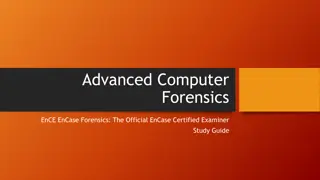Cutting-Edge Disk-Based Search Algorithms in Algorithm Engineering
Explore the world of algorithm engineering with a focus on disk-based search algorithms. Discover how recent successes have tackled challenges in solving complex problems such as the Rubik's Cube, puzzle games, and the Towers of Hanoi. Delve into techniques involving massive state spaces, heuristic search strategies, and the use of extensive computational resources to achieve optimal solutions in record times. Gain insights into external-memory algorithms, I/O complexity analysis, and advanced topics like probability and flash memory utilization.
Uploaded on Sep 26, 2024 | 4 Views
Download Presentation

Please find below an Image/Link to download the presentation.
The content on the website is provided AS IS for your information and personal use only. It may not be sold, licensed, or shared on other websites without obtaining consent from the author.If you encounter any issues during the download, it is possible that the publisher has removed the file from their server.
You are allowed to download the files provided on this website for personal or commercial use, subject to the condition that they are used lawfully. All files are the property of their respective owners.
The content on the website is provided AS IS for your information and personal use only. It may not be sold, licensed, or shared on other websites without obtaining consent from the author.
E N D
Presentation Transcript
Algorithm Engineering Externspeicherplatzsuche Stefan Edelkamp
Motivation: Recent Successes in Search Optimal solutions the RUBIK S CUBE, the (n 1)- PUZZLE, and the TOWERS-OF-HANOI problem, all with state spaces of about or more than a quintillion (a billion times a billion) states. When processing a million states per second, looking at all states corresponds to hundreds of thousands of years. Even with search heuristics, time and space remain crucial resources: in extreme cases, weeks of computation time, gigabytes of main memory and terabytes of hard disk space have been invested to solve search challenges.
Recent Examples Disk-based Search RUBIK S CUBE: 43,252,003,274,489,856,000 states, 1997: Solved optimally by a general-propose strategy, which used 110 megabytes of main memory for guiding the search, for the hardest instance the solver generated 1,021,814,815,051 states to find an optimum of 18 moves in 17 days. 2007: By performing a breadth-first search over subsets of configurations, starting with the solved one, in 63 hours with the help of 128 processor cores and 7 terabytes of disk space it was shown that 26 moves suffice.
Recent Examples of Disk-based Search With recent search enhancements, the average solution time for optimally solving the FIFTEEN-PUZZLE with over 10^13 states is about milliseconds, looking at thousands of states. The state space of the FIFTEEN-PUZZLE has been completely generated in 3 weeks using 1.4 terabytes of secondary memory. Tight bounds on the optimal solutions for the THIRTY- FIVE-PUZZLE with over 10^41 states have been computed in more than one month total time using 16 gigabytes RAM and 3 terabytes hard disk.
Recent Examples of Disk-based Search The 4-peg 30-disk TOWERS-OF-HANOI problem spans a state space of 430 = 1, 152, 921, 504, 606, 846, 976 states Optimally solved integrating a significant number of research results consuming about 400 gigabytes hard disk space in 17 days.
Outline Review of basic graph-search techniques, limited-memory graph search, including frontier search Introduction to External-Memory Algorithms and I/O Complexity Analysis External-Memory Search Algorithms Exploiting Problem Graph Structure Advanced Topics: Probability, Semi-Externality Flash-Memory, etc.
Notations G: Graph V: Set of nodes of G E: Set of edges of G w: E IR: Weight function that assigns a cost to each edge. : shortest path distance between two nodes. Open list: Search frontier waiting to be expanded. Closed list: Expanded nodes.
Heuristic Search A* algorithm g g A* s s Breadth- First Search A heuristic estimate is used to guide the search. E.g. Straight line distance from the current node to the goal in case of a graph with a geometric layout.
Comparison of Search Algorithms BFS DFS Best-First Search A*
Heuristics Admissible Heuristics Never over-estimates the optimal path. Guarantees the optimal path Consistent Heuristics Never drops fasters than the edge weight. Guarantees the minimum number of expanded nodes.
Divide-and-conquer frontier A* [Korf & Zhang AAAI-00] Stores Open list, but not Closed list Reconstructs solution using divide-and-conquer method Goal Frontier
Breadth-first heuristic search Breadth-first branch-and-bound is more memory-efficient than best- first search f(n) > U Breadth-first frontier Best-first frontier
Divide-and-conquer beam search Stores 3 layers for duplicate elimination and 1 middle layer for solution reconstruction Uses beam width to limit size of a layer Beam- width Start Start Goal
Divide-and-conquer beam-stack search Memory use bounded by 4 beam width Allows much wider beam width, which reduces backtracking If backtrack to removed layers, use beam stack to recover them
Example: width = 2, U = 8 Start A A [0, 3) 1 1 3 3 1 2 2 2 C C D C B B D B [0, 7) [7, 8) 3 3 3 3 1 1 5 5 2 2 2 1 5 [0, 8) F F E E E F G G G 4 4 6 1 6 Goal H H beam-stack
Iterative Broadening Breadth-First Branch-and-Bound 100% 80% 60% c o s t 40% k=20% Search frontier Only pick best k% nodes for expansion.
Enforced Hill-Climbing Most successful planning algorithm h=3 BFS h=2 h=1 h=0 Goal
Introduction to EM Algorithms Von Neumann RAM Model Virtual Memory External-Memory Model Basic I/O complexity analysis External Scanning External Sorting Breadth-First Search Graphs Explicit Graphs Implicit Graphs
Von Neumann RAM Model? Program Void foo(){ foobar(); } CPU Hea p Main assumptions: Program and heap fit into the main memory. CPU has a fast constant-time access to the memory contents.
Virtual Memory Management Scheme Address space is divided into memory pages. A large virtual address space is mapped to a smaller physical address space. If a required address is not in the main memory, a page-fault is triggered. A memory page is moved back from RAM to the hard disk to make space, The required page is loaded from hard disk to RAM.
Virtual Memory + works well when word processing, spreadsheet, etc. are used. does not know any thing about the data accesses in an algorithm. In the worst-case, can result in one page fault for every state access! 0x000 000 Address Space Virtual 7 I/Os Memory Page 0xFFF FFF
Memory Hierarchy Latency times Typical capcity Registers (x86_64) L1 Cache L2 Cache L3 Cache RAM Hard disk (7200 rpm) ~2 ns 16 x 64 bits 3.0 ns 17 ns 23 ns 86 ns 64 KB 512 KB 2 4 MB 4 GB 4.2 ms 600 GB
Working of a hard disk Data is written on tracks in form of sectors. While reading, armature is moved to the desired track. Platter is rotated to bring the sector directly under the head. A large block of data is read in one rotation.
External Memory Model [Aggarwal and Vitter] If the input size is very large, running time depends on the I/Os rather than on the number of instructions. M B Input of size N >> M
External Scanning Given an input of size N, consecutively read B elements in the RAM. M B B B B B B Input of size N N = ( ) scan N I/O complexity: B
External Sorting Unsorted disk file of size N Read M elements in chunks of B, sort internally and flush Read M/B sorted buffers and flush a merged and sorted sequence Read final M/B sorted buffers and flush a merged and sorted sequence N N I/O complexity: = ( ) log sort N O M B B B
Explicit vs. Implicit Actions: I 3 2 U: up D: down 1 4 5 U R L: left R: right 6 7 8 2 7 1 3 2 3 2 5 4 5 1 4 5 I T 1 3 8 10 6 7 8 6 7 8 6 1 2 4 9 3 4 5 8 T 6 7 Path search in explicit graphs: Given a graph, does a path between two nodes I and T exist? Path search in implicit graphs: Given an initial state(s) I and a set of transformation rules, is a desired state T reachable? Traverse/Generate the graph until T is reached. Search Algorithms: DFS,BFS, Dijkstra, A*, etc.) What if the graph is too big to fit in the RAM? 8-puzzle has 9!/2 states ... 15-puzzle has 16!/2 10 461 394 900 000 states
External-Memory Graph Search External BFS Delayed Duplicate Detection Locality External A* Bucket Data Structure I/O Complexity Analysis
External Breadth-First Search A C E B D A A A D D A B E D A D A D D C Open (2) E Open(0) E E Open(1)
I/O Complexity Analysis of EM-BFS for Explicit Graphs Expansion: Sorting the adjacency lists: O(Sort(|V|)) Reading the adjacency list of all the nodes: O(|V|) Duplicates Removal: Phase I: External sorting followed by scannig. O(Sort(|E|) + Scan(|E|)) Phase II: Subtraction of previous two layers: O(Scan(|E|) + Scan(|V|)) Total: O(|V| +Sort(|E| + |V|)) I/Os
Delayed Duplicate Detection (Korf 2003) Essentially idea of Munagala and Ranade applied to implicit graphs Complexity: Phase I: External sorting followed by scannig. O(Sort(|E|) + Scan(|E|)) Phase II: Subtraction of previous two layers: O(Scan(|E|) + Scan(|V|)) Total: O(Sort(|E|) + Scan (|V|)) I/Os
Duplicate Detection Scope 1 2 3 4 1 2 3 4 BFS Layer Undirected Graph Directed Graph Layer-0 {1} {1} {2} Layer-1 {2,4} [1,3,2,4]{3} {3} Layer-2 {4} {4} Layer-4 {1} Layer-5 = + Longest Back- edge: max | v S v { ) ( , ) ( , )} 1 locality I u I v , ( u Succ u [Zhou & Hansen 05]
Problems with A* Algorithm A* needs to store all the states during exploration. A* generates large amount of duplicates that can be removed using an internal hash table only if it can fit in the main memory. A* do not exhibit any locality of expansion. For large state spaces, standard virtual memory management can result in excessive page faults. Can we follow the strict order of expanding with respect to the minimum g+h value? - Without compromising the optimality?
Data Structure: Bucket A Bucket is a set of states, residing on the disk, having the same (g, h) value, where: g = number of transitions needed to transform the initial state to the states of the bucket, and h = Estimated distance of the bucket s state to the goal No state is inserted again in a bucket that is expanded. If Active (being read or written), represented internally by a small buffer. Insert states when full, sort and flush Buffer in internal memory File on disk
External A* heuristic Simulates a priority queue by exploiting the properties of the heuristic function: h is a total function!! Consistent heuristic estimates. h ={-1,0,1, } w (u,v) = w(u,v) h(u) + h(v) => w (u,v) = 1 + {-1,0,1} 0 1 h(I)=2 I 3 4 0 depth 1 2 3 G 4
External A* Buckets represent temporal locality cache efficient order of expansion. If we store the states in the same bucket together we can exploit the spatial locality. Munagala and Ranade s BFS and Korf s delayed duplicate detection for implicit graphs. External A*
Procedure External A* Bucket(0, h(I)) {I} fmin h(I) while (fmin ) g min{i | Bucket(i, fmin i) } while (gmin fmin) h fmin g Bucket(g, h) remove duplicates from Bucket(g, h) Bucket(g, h) Bucket(g, h) \ (Bucket(g 1, h) U Bucket(g 2, h)) // Subtraction A(fmin),A(fmin+ 1),A(fmin+ 2) N(Bucket(g, h)) // Generate Neighbours Bucket(g + 1, h + 1) A(fmin+ 2) Bucket(g + 1, h) A(fmin+ 1) U Bucket(g + 1, h) Bucket(g + 1, h 1) A(fmin) U Bucket(g + 1, h 1) g g + 1 fmin min{i + j > fmin| Bucket(i, j) } U { }
I/O Complexity Analysis Internal A* => Each edge is looked at most once. Duplicates Removal: Sorting the green bucket having one state for every edge from the 3 red buckets. Scanning and compaction. O(sort(|E|)) Total I/O complexity: (sort(|E|) + scan(|V|)) I/Os Cache-Efficient at all levels!!!
Complexity Analysis Subtraction: Removing states of blue buckets (duplicates free) from the green one. O(scan(|V|) + scan(|E|)) Total I/O complexity: (sort(|E|) + scan(|V|)) I/Os Cache-Efficient at all levels!!!
I/O Performance of External A* Theorem: The complexity of External A* in an implicit unweighted and undirected graph with a consistent heuristic estimate is bounded by O(sort(|E|) + scan(|V|)) I/Os.
Exploiting Problem Graph Structure Structured Duplicate Detection Basic Principles Manual and automated Partitioning Edge Partitioning External Memory Pattern Databases
Structured duplicate detection Idea: localize memory references in duplicate detection by exploiting graph structure Example: Fifteen-puzzle 2 2 4 4 8 ? 1 5 9 10 11 9 10 11 ? 3 3 ? 2 1 4 8 8 12 13 14 15 12 13 14 15 ? ? 3 7 7 7 ? ? ? 1 5 9 10 11 12 13 14 15 3 7 2 5 ? ? ? 1 ? ? 6 6 6 ? ? ? 5 9 10 11 12 13 14 15 6 4 8
State-space projection function Many-to-one mapping from original state space to abstract state space Created by ignoring some state variables Example ? ? ? ? ? ? ? ? ? ? ? ? ? ? ? ? ? ? ? ? ? ? ? ? ? ? ? ? ? ? ? ? ? ? ? ? ? ? ? ? ? ? ? ? ? 1 blank pos. = 0 15
Abstract state-space graph Created by state-space projection function Example B0 B1 B2 B3 2 1 5 9 10 11 12 13 14 15 3 7 B5 B6 B7 6 B4 4 8 B8 B9 B10 B11 B12 B13 B14 B15 > 10 trillion states 16 abstract states
Partition stored nodes Open and Closed lists are partitioned into blocks of nodes, with one block for each abstract node in abstract state-space graph B2 B14 B15 B0 B1 Logical memory
Duplicate-detection scope A set of blocks (of stored nodes) that is guaranteed to contain all stored successor nodes of the currently-expanding node B2 B3 B5 B2 B2 B3 B3 B0 B0 B1 B1 B8 B7 B6 B4 B5 B5 B6 B6 B7 B7 B0 B1 B4 B4 B15 B14 B8 B8 B9 B9 B10 B10 B11 B11 B12 B12 B13 B13 B14 B14 B15 B15 49
When is disk I/O needed? If internal memory is full, write blocks outside current duplicate- detection scope to disk If any blocks in current duplicate-detection scope are not in memory, read missing blocks from disk
